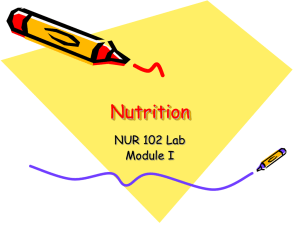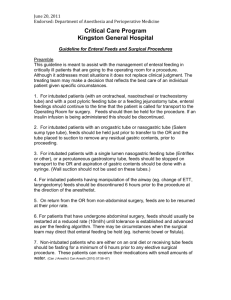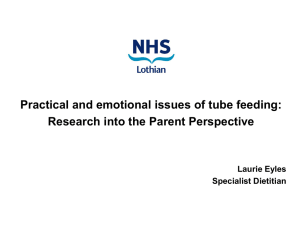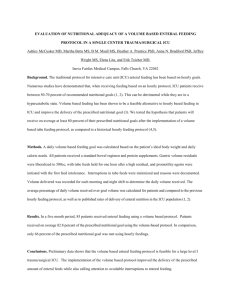Preventing errors when administering drugs via an enteral feeding
advertisement
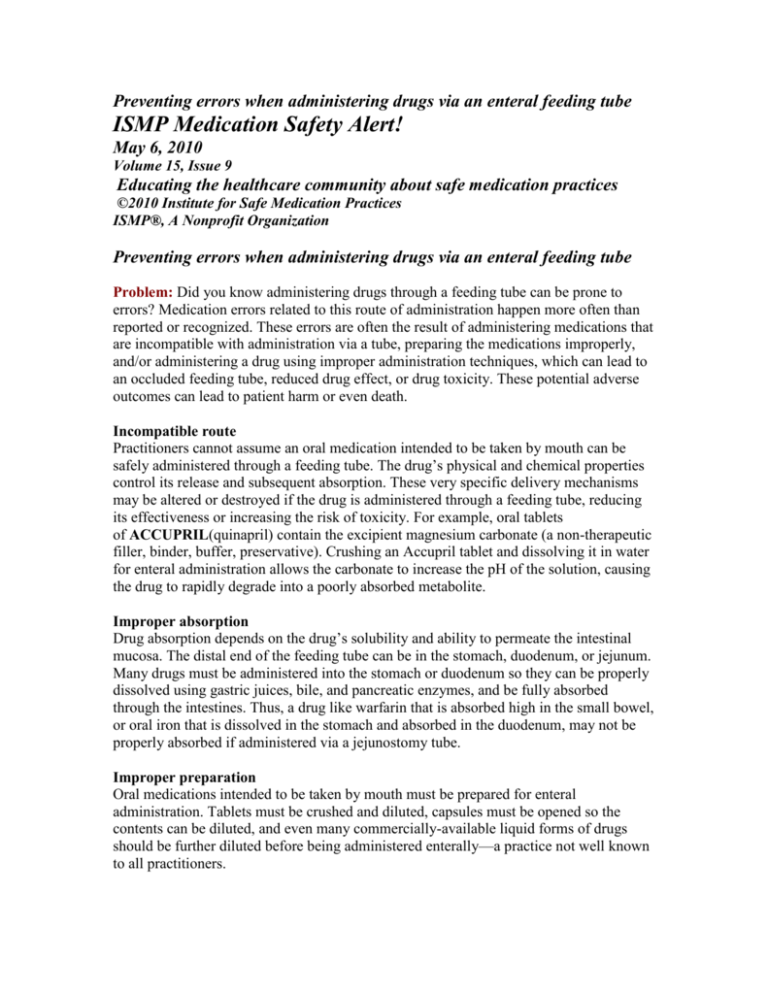
Preventing errors when administering drugs via an enteral feeding tube ISMP Medication Safety Alert! May 6, 2010 Volume 15, Issue 9 Educating the healthcare community about safe medication practices ©2010 Institute for Safe Medication Practices ISMP®, A Nonprofit Organization Preventing errors when administering drugs via an enteral feeding tube Problem: Did you know administering drugs through a feeding tube can be prone to errors? Medication errors related to this route of administration happen more often than reported or recognized. These errors are often the result of administering medications that are incompatible with administration via a tube, preparing the medications improperly, and/or administering a drug using improper administration techniques, which can lead to an occluded feeding tube, reduced drug effect, or drug toxicity. These potential adverse outcomes can lead to patient harm or even death. Incompatible route Practitioners cannot assume an oral medication intended to be taken by mouth can be safely administered through a feeding tube. The drug’s physical and chemical properties control its release and subsequent absorption. These very specific delivery mechanisms may be altered or destroyed if the drug is administered through a feeding tube, reducing its effectiveness or increasing the risk of toxicity. For example, oral tablets of ACCUPRIL(quinapril) contain the excipient magnesium carbonate (a non-therapeutic filler, binder, buffer, preservative). Crushing an Accupril tablet and dissolving it in water for enteral administration allows the carbonate to increase the pH of the solution, causing the drug to rapidly degrade into a poorly absorbed metabolite. Improper absorption Drug absorption depends on the drug’s solubility and ability to permeate the intestinal mucosa. The distal end of the feeding tube can be in the stomach, duodenum, or jejunum. Many drugs must be administered into the stomach or duodenum so they can be properly dissolved using gastric juices, bile, and pancreatic enzymes, and be fully absorbed through the intestines. Thus, a drug like warfarin that is absorbed high in the small bowel, or oral iron that is dissolved in the stomach and absorbed in the duodenum, may not be properly absorbed if administered via a jejunostomy tube. Improper preparation Oral medications intended to be taken by mouth must be prepared for enteral administration. Tablets must be crushed and diluted, capsules must be opened so the contents can be diluted, and even many commercially-available liquid forms of drugs should be further diluted before being administered enterally—a practice not well known to all practitioners. Many immediate-release tablets can be safely crushed into a fine powder and diluted prior to administration. But, sublingual, enteric-coated, and extended/delayed-release medications should not be crushed. In addition to destroying the drug’s protective coating, crushed enteric-coated tablets tend to clump and clog feeding tubes. Crushed sublingual or extended/delayed-release medications can lead to dangerous and erratic blood levels as well as dangerous side effects. Unfortunately, the variety of suffixes manufacturers use to denote an extended/delayed-release formulation—CD, CR, ER, LA, SA, SR, TD, TR, XL, XR—or the absence of these suffix designations, such as with AVINZA (morphine sulfate extended-release capsules) and OXYCONTIN (oxyCODONE controlled release), make it difficult to quickly determine whether a drug can be safely crushed. In these examples, the medications should not be crushed or dissolved. Crushing drugs such as TRACLEER (bosentan) or PROSCAR (finasteride), or opening ZAVESCA (miglustat) capsules, can expose nurses to powder that can cause serious birth defects. Some orally disintegrating tablets, such as PREVACID (lansoprazole) SOLUTABS, must not be crushed because they contain enteric-coated microgranules. Some capsules contain both immediate- and extended/delayed-release granules. With liquid-filled capsules, it is difficult to ensure that all the liquid has been removed to give the correct dose. Using a commercially-available liquid form of the medication or other preparations used to make oral suspensions may seem like a safe alternative, but some, such as Prevacid Oral Suspension Packets, may not be appropriate for administration via feeding tubes. Also, excipients in some oral solutions and suspensions, such as sweeteners, gums, stabilizers, and suspension agents, can increase viscosity and osmolality, causing diarrhea, clogged tubes, and/or undelivered medication left in the tube. Improper administration technique Most nurses rely primarily on their own experience and that of coworkers for information regarding the preparation and administration of enteral medications; few rely on pharmacists, nutritionists, or printed guidelines, which has resulted in a variety of improper techniques and an overall lack of consistency. The most common improper administration techniques include mixing multiple drugs together to give at once and failing to flush the tube before giving the first drug and between subsequent drugs. Appropriate administration techniques must be used to prevent compatibility issues (between medications and the feeding formula) and tube occlusions. Information about drug compatibility with feeding formulas is limited and may not be applicable to different formulations of the same drug or drugs within the same class. For example, liquid morphine in a 2 mg/mL concentration decreases the pH of the feeding formula and results in a precipitate, but a 20 mg/mL concentration does not. Compatibility issues between the formula and drug can result in tube occlusions. Compatibility between multiple drugs being administered together can also be a problem, particularly if two or more drugs are crushed and mixed together before administration. Mixing two or more drugs together, whether solid or liquid forms, creates a brand new, unknown entity with an unpredictable mechanism of release and bioavailability. Proper flushing of the tube before, between, and after each drug can help avoid problems. Safe Practice Recommendations: Within each organization, an interdisciplinary team of nurses, pharmacists, nutritionists, and physicians should work together to develop protocols for administering drugs through enteral feeding tubes. Protocols should address using appropriate dosage forms, preparing drugs for enteral administration, administering each drug separately, diluting drugs as appropriate, and flushing the feeding tube before, between, and after drug administration. The Enteral Nutrition Practice Recommendations, a comprehensive guide developed by an interdisciplinary task force in 2009, is available on the American Society for Parenteral and Enteral Nutrition’s (A.S.P.E.N.) Web site,www.nutritioncare.org/safety. A step-by-step guide of safe recommendations follows; however, the A.S.P.E.N. resource is of greatest value if employed in its entirety. Establish route suitability. Practitioners administering enteral medications should determine the location of the distal end of the feeding tube and consult with a pharmacist to ensure the medication(s) will be properly dissolved and absorbed. Establish drug and dosage form suitability. Practitioners should ensure that the drug and formulation are appropriate for enteral administration. Use only immediate-release solid dosage forms or liquid dosage forms. For solid dosage forms, refer to the up-todate Do Not Crush list (Mitchell, JF. Oral dosage forms that should not be crushed; available at: www.ismp.org/Tools/DoNot Crush.pdf) to help determine suitability. Nurses should consult with the pharmacist if they have questions or to see if liquid dosage forms are available and appropriate. The pharmacist can also contact the prescriber to switch to a different product more suitable for enteral tube administration when necessary. Prepare separately. Each medication should be prepared individually so it can be administered separately. Open capsules. Immediate-release gelatin capsules should be opened to remove the powder or to crush the solid contents. Crush solid dosage forms. Whenever possible, pharmacy staff should crush tablets into a fine powder using a fully self-contained, pill-crushing device (e.g., the Silent Knight), which prevents residue from one medicine being mixed with another. Allergenic, cytotoxic, carcinogenic, or teratogenic drugs should be crushed by a pharmacist under highly controlled conditions, and only when necessary. Dilute the medication. The crushed drug as well as liquid medications should be diluted. Purified water (e.g., sterile water) is the preferred diluent for most drugs. Tap water is not advised, as it often contains chemical contaminants (e.g., heavy metals, medications) that might interact with the drug. The diluted medication should be drawn up into an oral syringe and dispensed to the nursing unit ready for administration. Don’t mix medications with feeding formulas. Medication(s) should not be added directly to the feeding formula. Mixing drugs with the formula could cause drug-formula interactions, leading to tube blockages, altered bioavailability, and changes in bowel function. Flush. The feeding should be stopped and the tube flushed with at least 15 mL of purified water before and after administering each medication. Administer separately. Each medication should be administered separately through the feeding tube using a clean 30 mL or larger oral (non-luer tip) syringe. Flush again. The tube should be flushed again with at least 15 mL of purified water to ensure drug delivery and clear the tube. Restart the feeding. The feeding can usually be restarted after drug administration and flushing (some drugs require a delay of 30 minutes or more). Report and investigate. Any occlusion of a feeding tube or unexpected response to drug therapy should be reported and investigated to determine the cause. We thank Joseph Boullata, PharmD, RPh, BCNSP, for providing ISMP with the information for this article, which was adapted from an article he authored on the subject: Boullata, JI. Drug administration through an enteral feeding tube. Am J Nurs 2009;109(10):34-42.
